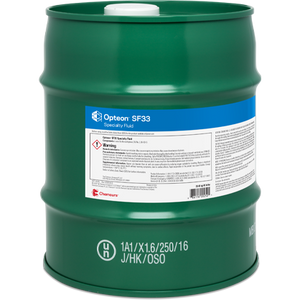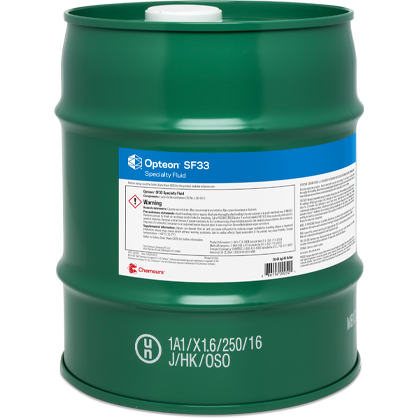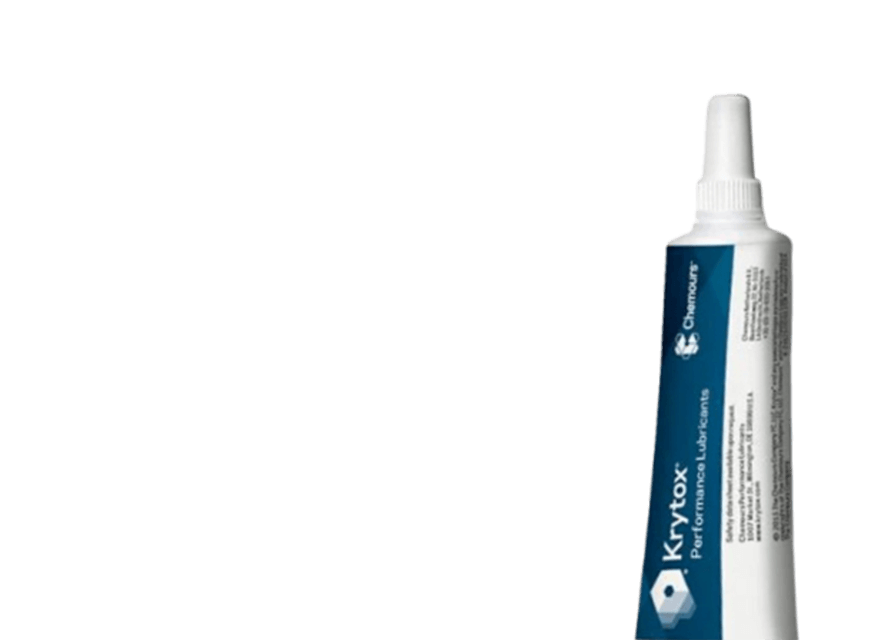



About
Opteon™ SF33 (HFO-1336mzz-Z) is a proprietary hydrofluoroolefin (HFO) specialty fluid with zero ozone depletion potential (ODP) and very low global warming potential (GWP) of 2, 100-yr ITH. It’s a clear, colorless, nonflammable, thermally stable, low toxicity, and environmental friendly fluid developed for cleaning, drying, and carrier fluid industrial solvent applications. The fluid has a boiling point of 33.4 °C (91.4 °F) and is appropriate for replacing PFCs, HCFCs, PFPEs, HFCs, and HFEs in industrial solvent applications.
APPLICATIONS
- Metal degreasing
- Lubricant deposition
- Electronics cleaning
- Precision cleaning
- Rinsing agent
- Aerosol solvent
- Heat transfer fluid
PHYSICAL PROPERTIES
| Property | Units | Opteon SF33 |
| Chemical Structure | Cis-CF3 CH=CHCF3 | |
| Molecular Weight | g/mol | 164 |
| Boiling Point | °C (°F) | 33.4 (92.1) |
| Freezing Point | °C (°F) | -107 (-160.6) |
| Density at 25 °C (77 °F) | g/cm3 | 1.36 |
| Viscosity at 25 °C (77 °F) | cP | 0.38 |
| Kb Value | 11.3 | |
| Dipole Moment | D | 2.9688 |
| Vapor Pressure at 25 °C (77 °F) | MPa | 0.07 |
| Flash Point, CC, ASTM D56 | °C (°F) | None |
| Flash Point, OC, ASTM D1310 | °C (°F) | None |
| Vapor Flammability, ASTM E681 | %vol | None |
| Water Solubility | ppm | 560 |
| Critical Temperature | °C (°F) | 171.3 (340.3) |
| Critical Pressure | MPa | 2.9 |
| Critical Density | g/cm3 | 0.471 |
| Heat of Vaporization at BP | kJ/kg | 166 |
| Liquid Thermal Conductivity at 25 °C (77 °F) | W/m-k | 0.077 |
| Liquid Specific Heat at 25 °C (77 °F) | kJ/kg-k | 1.2 |
| Surface Tension | N/m | 0.013 |
| Dielectric Constant | kV | 32 |
| Resistivity | ohm-cm | 10-8 |
| Break Down Voltage | 10 | |
| Global Warming Potential (GWP) | 100-yr ITH | 2 |
| Ozone Depletion Potential (ODP) | 0 | |
| Occupational Exposure Limit (OEL) | ppm | 500 |
PERFORMANCE
Temperature-Dependent Properties
| Temperature, °C (°F) | Pressure, MPa | Liquid Density, kg/m3 | Liquid Viscosity, cP |
| -30 (-22) | 0.0044441 | 1515.3 | 0.90765 |
| -25 (-13) | 0.0061359 | 1502.2 | 0.82347 |
| -20 (-4) | 0.0083332 | 1489.1 | 0.75125 |
| -15 (5) | 0.011146 | 1476.1 | 0.68869 |
| -10 (14) | 0.014697 | 1463.0 | 0.63404 |
| -5 (23) | 0.019125 | 1449.9 | 0.58594 |
| 0 (32) | 0.024582 | 1436.7 | 0.54330 |
| 5 (41) | 0.031237 | 1423.5 | 0.50529 |
| 10 (50) | 0.039271 | 1410.3 | 0.47119 |
| 15 (59) | 0.048882 | 1396.9 | 0.44045 |
| 20 (68) | 0.060278 | 1383.5 | 0.41260 |
| 25 (77) | 0.073686 | 1370.0 | 0.38726 |
| 30 (86) | 0.089343 | 1356.3 | 0.36409 |
| 35 (95) | 0.10733 | 1335.3 | 0.28679 |
MATERIALS COMPAIBILITY
Metals
Opteon™ SF33 is compatible with most metals. Exposures to stainless steel, copper, brass, and aluminum at 100 °C (212 °F) for 2 weeks showed good stability as summarized below. Opteon™ SF33 is not compatible with strong bases; therefore, contact with highly basic process materials is not recommended. Contact with strong Lewis acids, such as aluminum trichloride, alkali and alkaline earth metals, powdered metals, and powdered metal salts, is also not recommended.
Plastics:
Opteon™ SF33 is compatible with most plastics. Exposures to most plastics at room temperature for 2 weeks showed good compatibility. Consult with your local Chemours specialty fluids representative to help answer questions about specific materials compatibility in your application.
Elastomers:
Exposures to most elastomers at room temperature for 2 weeks show compatibility. Some reversible swelling is expected with partially fluorinated elastomers. Consult with your local Chemours specialty fluids representative to help answer questions about specific materials compatibility in your application.
Metals Compatibility: Exposure @ 100°C for Two Weeks
| Metal | Weight Loss | Surface Appearance | Solvent Appearance | Fluoride IC |
| Aluminum | None | No Change | Clear, Colorless | <0.5 ppm |
| Copper | None | No Change | Clear, Colorless | <0.5 ppm |
| Brass | None | No Change | Clear, Colorless | <0.5 ppm |
| Stainless Steel | None | No Change | Clear, Colorless | <0.5 ppm |
| Carbon Steel | None | No Change | Clear, Colorless | <0.5 ppm |
Plastics Compatibility: Test @ Room Temperature for Two Weeks
| Symbol | Material | % Weight Change | % Volume Change | % Hardness Change |
| ABS | Acrylonitrile-Butadiene- Styrene | -0.1 | -0.6 | 0.0 |
| HIPS | High Impact Polystyrene | 0.3 | -0.4 | -2.9 |
| PET | Poly (Ethylene Terephthalate) | 0.0 | 0.7 | -1.2 |
| PS | Polystyrene | -0.4 | 0.9 | 0.0 |
| PVC | Polyvinyl Chloride | 0.0 | 0.0 | 0.0 |
| CPVC | Chlorinated Polyvinyl Chloride | 0.0 | -0.3 | 0.0 |
| PTFE | Fluorocarbon | 1.1 | 0.3 | -17.2 |
| ETFE | Fluorocarbon | 0.7 | 0.0 | 12.9 |
| POM | Acetal | 0.1 | -1.2 | -1.3 |
| PEEK | Polyetheretherketone | 0.0 | 0.2 | 0.0 |
| LCP | Polyester | 0.0 | -0.4 | -1.5 |
| PEI | Polyetherimide | -0.1 | 0.0 | 0.0 |
| PVDF | Polyvinylidene Fluoride | 0.0 | -0.3 | 0.0 |
| PP | Polypropylene | 0.3 | -0.5 | 0.0 |
| HDPE | High Density Polyethylene | 0.0 | 0.3 | 3.3 |
Elastomers Compatibility: Test @ Room Temperature for Two Weeks
| Symbol | Material | % Weight Change | % Volume Change | % Hardness Change |
| NR | Natural Rubber | 4.4 | 1.9 | 0.0 |
| CR | Polychloroprene | 0.8 | 0.1 | 0.0 |
| NBR | Acrylonitrile Butadiene | 15.3 | 2.6 | -13.6 |
| FKM | Fluoroelastomer | 7.9 | -3.4 | -2.9 |
| T | Thiokol | 0.3 | 6.7 | -6.1 |
| IIR | Isobutylene Isoprene | 0.3 | 13.1 | -13.3 |
| EPDM | Ethylene Propylene Terpolymer | 1.4 | 5.5 | -7.1 |
| CSM | Chlorosulfonated Polyethylene | 0.2 | 0.8 | -1.3 |
Safety, Toxicity, and Environmental Properties
| Units | SF01 | SF05 | SF33 | SF30 | SF80 | |
| Flash Point, CC, ASTM D56 | °C (°F) | None | None | None | None | None |
| Flash Point, OC, ASTM D1310 | °C (°F) | None | None | None | None | None |
| Ozone Depletion Potential | – | 0 | 0 | 0 | 0 | 0 |
| Global Warming Potential | – | <10 | <10 | 2 | <2.5 | <2.5 |
| Occupational Exposure Limit | ppm | 526 | 636 | 500 | 425 | 1278 |
| Volatile Organic Compounds (VOCs) | g/L | 40 | 508 | – | 335 | 202 |
STORAGE & HANDLING
Opteon™ SF33 is thermally stable and does not oxidize or degrade during storage. It exhibits no closed or open cup flash point and is not classified as a flammable liquid by NFPA or DOT. Store in a clean, dry area; protect from freezing temperatures; and don’t allow stored product to exceed 46 °C (115 °F) to prevent leakage or potential rupture from pressure and expansion. Drum pumps are recommended to dispense fluid from its container. Vapor degreasing equipment with vapor containment technology are required to enable safe and economical use of the solvent. The fluid is a pure component material and easily recoverable by off-line and in-line distillation equipment, such as a vapor degreaser. Spent solvent that cannot be recycled should be tested to ensure proper classification for waste disposal. Additional safety information can be found in the Safety Data Sheet (SDS).
Opteon™ SF33 (HFO-1336mzz-Z) is a proprietary hydrofluoroolefin (HFO) specialty fluid with zero ozone depletion potential (ODP) and very low global warming potential (GWP) of 2, 100-yr ITH. It’s a clear, colorless, nonflammable, thermally stable, low toxicity, and environmental friendly fluid developed for cleaning, drying, and carrier fluid industrial solvent applications. The fluid has a boiling point of 33.4 °C (91.4 °F) and is appropriate for replacing PFCs, HCFCs, PFPEs, HFCs, and HFEs in industrial solvent applications.
APPLICATIONS
- Metal degreasing
- Lubricant deposition
- Electronics cleaning
- Precision cleaning
- Rinsing agent
- Aerosol solvent
- Heat transfer fluid
PHYSICAL PROPERTIES
| Property | Units | Opteon SF33 |
| Chemical Structure | Cis-CF3 CH=CHCF3 | |
| Molecular Weight | g/mol | 164 |
| Boiling Point | °C (°F) | 33.4 (92.1) |
| Freezing Point | °C (°F) | -107 (-160.6) |
| Density at 25 °C (77 °F) | g/cm3 | 1.36 |
| Viscosity at 25 °C (77 °F) | cP | 0.38 |
| Kb Value | 11.3 | |
| Dipole Moment | D | 2.9688 |
| Vapor Pressure at 25 °C (77 °F) | MPa | 0.07 |
| Flash Point, CC, ASTM D56 | °C (°F) | None |
| Flash Point, OC, ASTM D1310 | °C (°F) | None |
| Vapor Flammability, ASTM E681 | %vol | None |
| Water Solubility | ppm | 560 |
| Critical Temperature | °C (°F) | 171.3 (340.3) |
| Critical Pressure | MPa | 2.9 |
| Critical Density | g/cm3 | 0.471 |
| Heat of Vaporization at BP | kJ/kg | 166 |
| Liquid Thermal Conductivity at 25 °C (77 °F) | W/m-k | 0.077 |
| Liquid Specific Heat at 25 °C (77 °F) | kJ/kg-k | 1.2 |
| Surface Tension | N/m | 0.013 |
| Dielectric Constant | kV | 32 |
| Resistivity | ohm-cm | 10-8 |
| Break Down Voltage | 10 | |
| Global Warming Potential (GWP) | 100-yr ITH | 2 |
| Ozone Depletion Potential (ODP) | 0 | |
| Occupational Exposure Limit (OEL) | ppm | 500 |
PERFORMANCE
Temperature-Dependent Properties
| Temperature, °C (°F) | Pressure, MPa | Liquid Density, kg/m3 | Liquid Viscosity, cP |
| -30 (-22) | 0.0044441 | 1515.3 | 0.90765 |
| -25 (-13) | 0.0061359 | 1502.2 | 0.82347 |
| -20 (-4) | 0.0083332 | 1489.1 | 0.75125 |
| -15 (5) | 0.011146 | 1476.1 | 0.68869 |
| -10 (14) | 0.014697 | 1463.0 | 0.63404 |
| -5 (23) | 0.019125 | 1449.9 | 0.58594 |
| 0 (32) | 0.024582 | 1436.7 | 0.54330 |
| 5 (41) | 0.031237 | 1423.5 | 0.50529 |
| 10 (50) | 0.039271 | 1410.3 | 0.47119 |
| 15 (59) | 0.048882 | 1396.9 | 0.44045 |
| 20 (68) | 0.060278 | 1383.5 | 0.41260 |
| 25 (77) | 0.073686 | 1370.0 | 0.38726 |
| 30 (86) | 0.089343 | 1356.3 | 0.36409 |
| 35 (95) | 0.10733 | 1335.3 | 0.28679 |
MATERIALS COMPAIBILITY
Metals
Opteon™ SF33 is compatible with most metals. Exposures to stainless steel, copper, brass, and aluminum at 100 °C (212 °F) for 2 weeks showed good stability as summarized below. Opteon™ SF33 is not compatible with strong bases; therefore, contact with highly basic process materials is not recommended. Contact with strong Lewis acids, such as aluminum trichloride, alkali and alkaline earth metals, powdered metals, and powdered metal salts, is also not recommended.
Plastics:
Opteon™ SF33 is compatible with most plastics. Exposures to most plastics at room temperature for 2 weeks showed good compatibility. Consult with your local Chemours specialty fluids representative to help answer questions about specific materials compatibility in your application.
Elastomers:
Exposures to most elastomers at room temperature for 2 weeks show compatibility. Some reversible swelling is expected with partially fluorinated elastomers. Consult with your local Chemours specialty fluids representative to help answer questions about specific materials compatibility in your application.
Metals Compatibility: Exposure @ 100°C for Two Weeks
| Metal | Weight Loss | Surface Appearance | Solvent Appearance | Fluoride IC |
| Aluminum | None | No Change | Clear, Colorless | <0.5 ppm |
| Copper | None | No Change | Clear, Colorless | <0.5 ppm |
| Brass | None | No Change | Clear, Colorless | <0.5 ppm |
| Stainless Steel | None | No Change | Clear, Colorless | <0.5 ppm |
| Carbon Steel | None | No Change | Clear, Colorless | <0.5 ppm |
Plastics Compatibility: Test @ Room Temperature for Two Weeks
| Symbol | Material | % Weight Change | % Volume Change | % Hardness Change |
| ABS | Acrylonitrile-Butadiene- Styrene | -0.1 | -0.6 | 0.0 |
| HIPS | High Impact Polystyrene | 0.3 | -0.4 | -2.9 |
| PET | Poly (Ethylene Terephthalate) | 0.0 | 0.7 | -1.2 |
| PS | Polystyrene | -0.4 | 0.9 | 0.0 |
| PVC | Polyvinyl Chloride | 0.0 | 0.0 | 0.0 |
| CPVC | Chlorinated Polyvinyl Chloride | 0.0 | -0.3 | 0.0 |
| PTFE | Fluorocarbon | 1.1 | 0.3 | -17.2 |
| ETFE | Fluorocarbon | 0.7 | 0.0 | 12.9 |
| POM | Acetal | 0.1 | -1.2 | -1.3 |
| PEEK | Polyetheretherketone | 0.0 | 0.2 | 0.0 |
| LCP | Polyester | 0.0 | -0.4 | -1.5 |
| PEI | Polyetherimide | -0.1 | 0.0 | 0.0 |
| PVDF | Polyvinylidene Fluoride | 0.0 | -0.3 | 0.0 |
| PP | Polypropylene | 0.3 | -0.5 | 0.0 |
| HDPE | High Density Polyethylene | 0.0 | 0.3 | 3.3 |
Elastomers Compatibility: Test @ Room Temperature for Two Weeks
| Symbol | Material | % Weight Change | % Volume Change | % Hardness Change |
| NR | Natural Rubber | 4.4 | 1.9 | 0.0 |
| CR | Polychloroprene | 0.8 | 0.1 | 0.0 |
| NBR | Acrylonitrile Butadiene | 15.3 | 2.6 | -13.6 |
| FKM | Fluoroelastomer | 7.9 | -3.4 | -2.9 |
| T | Thiokol | 0.3 | 6.7 | -6.1 |
| IIR | Isobutylene Isoprene | 0.3 | 13.1 | -13.3 |
| EPDM | Ethylene Propylene Terpolymer | 1.4 | 5.5 | -7.1 |
| CSM | Chlorosulfonated Polyethylene | 0.2 | 0.8 | -1.3 |
Safety, Toxicity, and Environmental Properties
| Units | SF01 | SF05 | SF33 | SF30 | SF80 | |
| Flash Point, CC, ASTM D56 | °C (°F) | None | None | None | None | None |
| Flash Point, OC, ASTM D1310 | °C (°F) | None | None | None | None | None |
| Ozone Depletion Potential | – | 0 | 0 | 0 | 0 | 0 |
| Global Warming Potential | – | <10 | <10 | 2 | <2.5 | <2.5 |
| Occupational Exposure Limit | ppm | 526 | 636 | 500 | 425 | 1278 |
| Volatile Organic Compounds (VOCs) | g/L | 40 | 508 | – | 335 | 202 |
STORAGE & HANDLING
Opteon™ SF33 is thermally stable and does not oxidize or degrade during storage. It exhibits no closed or open cup flash point and is not classified as a flammable liquid by NFPA or DOT. Store in a clean, dry area; protect from freezing temperatures; and don’t allow stored product to exceed 46 °C (115 °F) to prevent leakage or potential rupture from pressure and expansion. Drum pumps are recommended to dispense fluid from its container. Vapor degreasing equipment with vapor containment technology are required to enable safe and economical use of the solvent. The fluid is a pure component material and easily recoverable by off-line and in-line distillation equipment, such as a vapor degreaser. Spent solvent that cannot be recycled should be tested to ensure proper classification for waste disposal. Additional safety information can be found in the Safety Data Sheet (SDS).
OPTEON™ SF33
Translation missing: en.products.product.sku:9733-10
- Regular price
- $408.50
- Sale price
- $408.50
- Regular price
-
Shipping Policy
Shipping Policy
Return Policy
Return Policy
Manufacturer P/N: 0000
CAS#: 692-49-9
Harmonized Tariff#: 2903.39
Schedule B#: 2903.39.9090
ECCN#: EAR99 EC/List#: 700-651-7
UFI#:
Index#:
EU-REACH#: 01-2119929623-35-0000
K-REACH#:
Trade Description: Hydrofluoroolefin Heat Transfer Fluid
Country of Origin: United States








